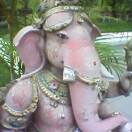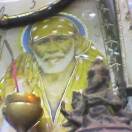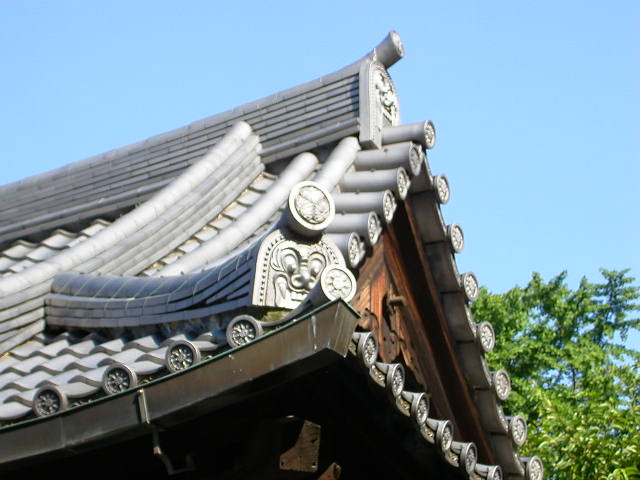|
 
|
g o d s - o f - i n d i a ++ GANESHA
PAST LIFE HISTORY ---- The 8 Incarnations of Lord Ganesha.
THE HINDU CLASSICS CLAIM THAT GANESHA HAS ENJOYED EIGHT PHYSICAL INCARNATIONS -- well, eight main incarnations anyway.
According to the Mudgalpurana (20/5-12), the incarnations are: Vakratunda, Ekdunta, Mahodara, Gajanana, Lambodara, Vikata, Vighnaraja, and Dhoomravarna. Yes, he does have an elephant trunk in every single one of these incarnations! Most of his lives seem to involve slaying demons! But each lifetime was different in some way, and his mode of carriage (the animal he rode) changed in certain lifetimes -- in one life he rode a peacock and in another he traded his ever-reliable mouse, for a noble lion!
There is an easy to notice symbolic function in these eight incarnations. In each lifetime, Ganesha fought against and subdued a different demon. Each demon relates to a flaw in human nature, something which needs to be overcome before one can become a Higher Man. The eight weaknesses which Ganesha spent eight lifetimes overcoming are: jealousy, drunkeness, illusion, greed, anger, desire, egotism, and self-infatuation (arrogance).

INCARNATION 1 ---- Vakratunda.
IN HIS FIRST INCARNATION, GANESHA WAS KNOWN AS VAKRATUNDA (THE CURVED TRUNK ONE). If you see Ganesha pictured with a curved trunk, you can assume this is a celebration of Ganesha's first lifetime. Basically, Vakratunda was the Ganesha who slayed the demon Matsarasura, and his vehicle is the lion on which he is seated. Matsarasura (or Matsara) was (and still is) a symbol of jealousy. Thus symbolically, Ganesha/Vakratunda is the god who destroys and overcomes the destructive power of jealousy.

INCARNATION 2 ---- Ekdunta.
IN HIS SECOND INCARNATION, GANESHA PLAYED THE ROLE OF "EKDUNTA", WITH THE MOUSE AS HIS MODE OF CONVEYANCE. He fought the demon Madasur and managed to subdue him. Ekdunta (or Ekadanta) means "the Lord who has only one tusk". Madasur (or Mada) was the demon of drunkeness.
 One question for the scholars: why does Ganesha have only one tusk? The reason for this, according to Padma Purana, is that one day when Lord Shiva was sleeping, sage Parashurama came to visit him. However, Ganesha would not allow Parashurama in, for his father's sleep would be disturbed. When Parashurama insisted he be permitted entry, a fight broke out. In the course of their struggle, Parashurama threw his axe at Ganesha. This axe had been given to Parashurama by Lord Shiva. Recognizing the axe and out of reverence for his father, Ganesha refused to intercept the weapon. He bowed and took its impact on one of his tusks, which broke. This broken tusk was used by him to write the epic, Mahabharata. Ganesha, the embodiment of wisdom, is also depicted as a scribe to whom sage Vyasa dictated the Mahabharata. He is accepted as the god of learning and the patron of letters. One question for the scholars: why does Ganesha have only one tusk? The reason for this, according to Padma Purana, is that one day when Lord Shiva was sleeping, sage Parashurama came to visit him. However, Ganesha would not allow Parashurama in, for his father's sleep would be disturbed. When Parashurama insisted he be permitted entry, a fight broke out. In the course of their struggle, Parashurama threw his axe at Ganesha. This axe had been given to Parashurama by Lord Shiva. Recognizing the axe and out of reverence for his father, Ganesha refused to intercept the weapon. He bowed and took its impact on one of his tusks, which broke. This broken tusk was used by him to write the epic, Mahabharata. Ganesha, the embodiment of wisdom, is also depicted as a scribe to whom sage Vyasa dictated the Mahabharata. He is accepted as the god of learning and the patron of letters.

INCARNATION 3 ---- Mahodara.
IN HIS THIRD INCARNATION, GANESHA ASSUMED THE FORM OF "MAHODARA", ONCE AGAIN USING THE MOUSE AS HIS VEHICLE. Mahodara contested the demon Mohasur, and won. In fact Ganesha/Mahodara was so successful that Mohasur became a staunch supporter, effectively won over to the Good Side of the Force. Ganesha/Mahodara also slew two other demons, Durbuddhi and his son Jnanaari.
This quote comes from Mahodara -- Astha Vinayaka, concerning the fell dictatorship of the Demon Mohasur: "Mohasur (sic) worshipped the Sun God and attained the name of DaityaRaja meaning King of the Demons. He also conquered all the three worlds...
"All the gods, sages hid in caves and jungles in fear of him. There was anarchy all over. At this time Surya, Sun God advised all the gods to worship Mahodara.
"All the Gods and the Sages started worshipping Mahodara (he is really Ganesha, remember?) At last Mahodara/Ganesha was pleased with their devotion and blessed them, by saying that he would slay Mohasur himself.
"When Shukracharya heard this, he told Mohasur to surrender in front of Mahodara. Lord Vishnu also explained to Mohasur that if he surrendered he will not be killed or destroyed. That's why he should accept the friendship of Mahodara. By saying this he started praising and singing the glories of Lord Lambodara.
"Listening to this Mohasur became frightened and he requested Lord Vishnu to bring Mahodara giving him due honour and respect.
"When Lord Mahodara arrived, Mohasur greeted and welcomed him with pomp and gaiety. He sang his praises and asked for forgiveness for his evil sins. Mohasur promised the gods that he would return them their Swargalok and assured that he would be always on the path of righteousness. He also assured them that henceforth, he would not a dare to harass the Gods and Sages.
"Listening to this Lord Mahodara was pleased and commanded him to go back to Pataal lok and never return again. All the Gods and the Sages were elated, They all started singing the praise of Lord Mahodara. (This tale) is situated in Taluka Kholapur, District Raigad."

INCARNATION 4 ---- Gajanana.
IN HIS FOURTH INCARNATION, GANESHA ASSUMED THE FORM OF "GAJANANA", WITH THE MOUSE AS HIS VEHICLE. Gajanana made the demon Lobhasur or Lobha (son of Kuber) submit and surrender before him, before putting him to death. Gajanana means "the Lord with an elephant face", and Lobha was the demon of greed.

INCARNATION 5 ---- Lambodara.
THE LORD WITH THE PROTUBERANT BELLY, WHO MASTERED KRODHA, THE DEMON OF ANGER. Ganesha's ever-present obesity is emphasized in this particular manifestation. For the Ganapatiya devotees, who consider Ganesha as the Supreme God and the Master of the Universe, the sweet given as offerings are seen like seeds of innumerable worlds inhabited by innumerable living creatures, and the god's belly is large enough to contain within all these worlds and creatures.

INCARNATION 6 ---- Vikata.
VIKATA ("THE MISSHAPEN"), WHO SUBDUED KAMA (KAMASUR), THE DEMON OF DESIRE. Interestingly, Ganesha traded in his Mouse Vehicle to ride a peacock in this manifestation.

INCARNATION 7 ---- Vighnaraja.
VIGHNARAJA, THE 7th INCARNATION OF GANESHA, HAD AN EVEN MORE UNUSUAL MODE OF CONVEYANCE -- a Sheshnaag or Shasha. In this lifetime Ganesha managed to subdue the demon Mamasur (also known as Mamtasur or Mama), the demon of the ego.
The Hindustan Times has this story to tell of Vighnaraja: "This is His (Ganesha's) most popular incarnation, known as The Remover of Obstacles. Riding his vehicle called Sheshnag, a serpent, he strode into battle with Mamtasur, and overcame him."

INCARNATION 8 ---- Dhoomravarna.
IN HIS FINAL INCARNATION, GANESHA RETURNED TO HAVING A MOUSE AS HIS VEHICLE. His life mission this time around was to defeat the demon Ahamkarasur, the demon of self-infatuation.
It is worth noting that (as all India-philes must know!) the word "Aham" means the human ego. Aham is the demonic force which grips the human mind like a vice, with cruelty and deception, and never lets go until the very bitter end. Like a parasitic worm Aham is so entrenched in the psyche, the human host eventually thinks that this is all that s/he can identify with. This demon has also been called Ahamkarasur, or Abhimanasur, both words again pointing to the inextricable control of the ego on the human. Ganesha can smash the bonds of your ego, if you call on Him. So call on Him. Go ahead and do it!
|
How Did Ganesha Get an Elephant's Head? |
How the Mouse Became Ganesha's Vehicle |
How to do Ganesha Puja at Home |
Moon Cursed by Ganesha |
Origin of Ganesha
|
Symbolism of Ganesha's Body |
The Remover of Obstacles
Clairvoyance | Download Bollywood Movies | Download Tamil Fonts |
Hindu Gods | Hindu Saints | Hindu Thought | Indian Palmistry | Indian Medicine | Yoga | Mantras | Yantras | Subcontinental Travel Guide
Contact the author Rob Sullivan at coderot@gmail.com. Anticopyright September 2009.

|
|
f e e d b a c k
purushottam (purshu@gmail.com)
says: "What a comprehensive view of the gods of india..really enjoyed it. I thank u for the clarity this article has given me in my seeking.
"I used to be a die hard atheist since childhood-praying to Shiva, vishnu, krishna, ganesha, saraswati, hanuman etc. I beleived in ONE omnipotent,omniscient, omnipresent God.
"But my recent experience with a spiritual master and organization took me towards Advaita philosophy-which makes possible the existence of many gods and the god inherent in every one of us. With the possibility of man becoming GOD one day, it has obviated my belief in 'one GOD for all'.
"So my allegiance shifted from Dvaita(dualistic) to the Advaita(non dualistic) shcheme of things, where there is no radical difference between man and god as man is god's low frequency existence,capable of reaching godhood by various means(bhakti,gyan,karma,meditation,etc).
"All this was fine till i realized that this advaita concept of GOD is effectively atheism in the eyes of a monotheist.
"Nevermind, 'reailty is relative'-I said to myself and continued my journey inwards.("One should have the courage of following truth to wherever it takes").
"WIth my beleif in God shaken, I decided to test my second most prized belief-the concept of Atman through the Advaitic Lens...."
JOIN THE CONVERSATION!

What are your thoughts on Hindu gods? Who is your favourite god (the One you worship?) Or are you losing your religion, as the old REM song went?
View Comments
Post Comments
|
|
|
